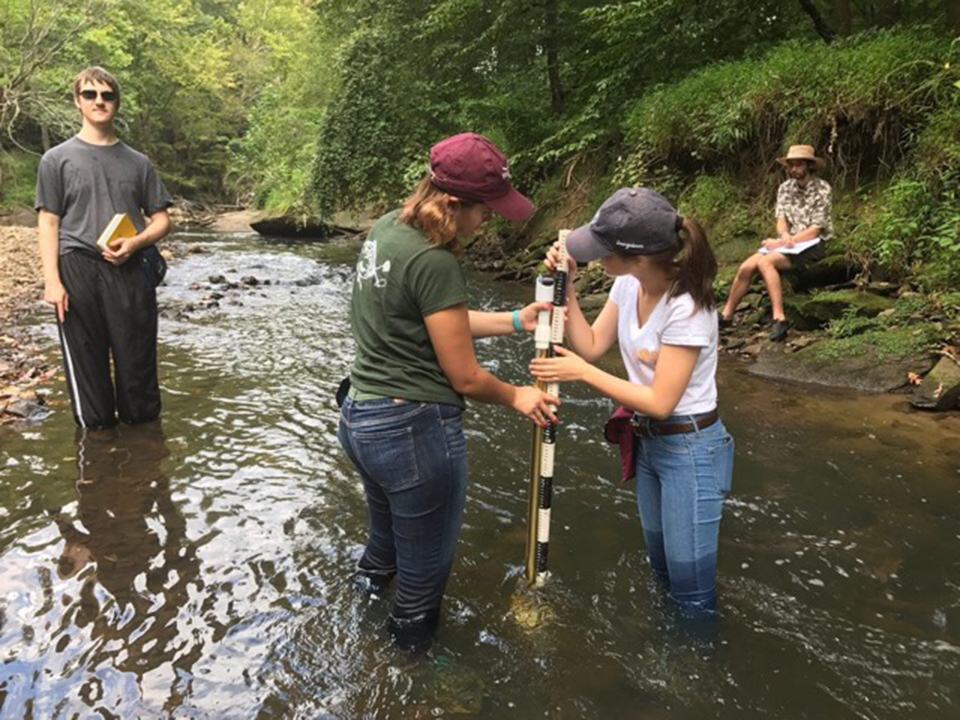By Kristen Mitchell
Helena Salvi, B.S. ’18, spent her academic career at George Washington University trying to make the world a better, more sustainable place. As a newly-minted School of Engineering and Applied Science graduate, she has continued her work blending the fields of engineering and biology.
Ms. Salvi has contributed to several long-term, interdisciplinary research projects at GW, and has spent her summer wrapping up loose ends before transitioning her work to a new generation of student leaders. She plans to continue building bridges through engineering and biology in her post-graduate career.
Read more about what Ms. Salvi is working on this summer:
Q: What kind of research are you working on this summer?
A: I’m working on a few projects, including a tidal irrigation system for Professor Keryn Gedan of the Biology Department. The tidal irrigation system will mimic the rise and fall of tides for plants that grow along coastlines for Dr. Gedan’s research on the ecological effect of freshwater-saltwater mixing, or salt intrusion, in the Chesapeake Bay.
Another is an aquaponics system with the Aquaponics R&D Team that I started in the Harlan Greenhouse. The aquaponics system has been an ongoing project since my freshman year and is an irrigation/aquaculture method in which plants filter waste from fish culture in a symbiotic relationship, which was developed to educate biologists and engineers at GW about problems faced by the field of sustainable agriculture.
Lastly, I’m doing some laser-optics research with oysters in Professor Philippe Bardet’s Thermo-Fluids Lab. This is a collaboration between the engineering and biology departments by implementing fluid-diagnostics methods on oysters in order to observe how they breath underwater. In short, we’re shooting lasers at the oysters to illuminate the changing oxygen concentrations in the water. Oxygen concentrations in marine environments are of course very important to all the life that inhabits it.
Q: What is your primary research goal?
A: I aim to promote sustainability and conservation at GW. It’s great to talk about it and spread the word, like so many organizations at GW do, but I’ve never been good at the outreach aspect. The best I can do to help is use the problem-solving skills I learned in engineering by researching sources of change in the environment and developing sustainable systems and solutions.
Q: What got you interested in this line of work?
A: There’s a saying for engineers that, “any sufficiently advanced technology is indistinguishable from magic,” which means that if you can make something work that no one else understands or thought was possible, then the products of this technology are just as good as magic to the world. I think nature is the most sufficiently advanced technology available to us, and like some engineers are into cars or computers, nature has me under its spell. I think there are solutions in nature that we don’t see because we haven’t begun to understand how it all works.
Q: What is one challenge you’ve faced so far and how have you tackled it?
A: Over the past four years, it’s become apparent that the concept of Aquaponics is much more complicated than all the cute infographics suggest, and due to over-commercialization, there is not much information available about the process that isn’t proprietary. One of the major goals of the Aquaponics R&D Team is to legitimize our work beyond its commercial marketability. To do this we seek sources of funding, such as the school and alumni, that allow us to continue our work.
Q: Did you receive any scholarships or funding that allowed you to complete this work?
A: For the tidal irrigation and aquaponics systems I’ve sought and received funding through the Biology Department, Engineering Department and Dr. Gedan. We’re working on getting more funding for the aquaponics team through alumni and various greenhouse donors. The oyster work is primarily through the thermo-fluids lab and Dr. Bardet, as well as Dr. Gedan and Professor Tara Scully of the Biology Department.
I attended GW with the School of Engineering and Applied Science Scholarship and also received assistance from the Ron Howard Student Assistance Fund, which really helped me through a tight spot.
Q: What do you hope to have learned by the end of the summer?
A: I’d like to have all the kinks worked out of the tidal system and fully train the new generation of the Aquaponics R&D Team. I’d like more laser experience. It’s hard to say what I would like to learn because I think engineering learning is made through mistakes you didn’t foresee. By the end of summer, I hope to have a full-time position in sustainable agriculture, agricultural fluid applications or aquaculture.
To learn more about available research opportunities contact the GW Center for Undergraduate Fellowships and Research.



